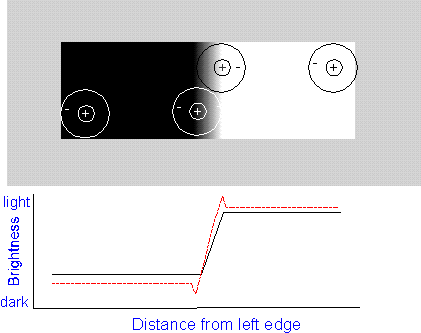Mach bands

The receptive fields are represented as a disk (+) and annulus (-). The center disk is an
excitatory area and the annulus an inhibitory area. The receptive fields in the uniformly
white and uniformly black areas receive about the same stimulation in their excitatory
centers and inhibitory surrounds. Therefore the center excitations are in balance with the
surround inhibitions.
The receptive field over the bright Mach Band gives a stronger response in the center
because part of the surround is in the darker area. Therefore it receives less inhibition
from the surround than did the center at the extreme left and right ends. The receptive
field over the dark band receives more surround inhibition because part of the surround is
in the brighter area. Therefore, the excitatory response is less and this results in our
seeing that the area as darker.
Fun Things
Table of Contents
Subject Index
Table of Contents [When not using frames]
